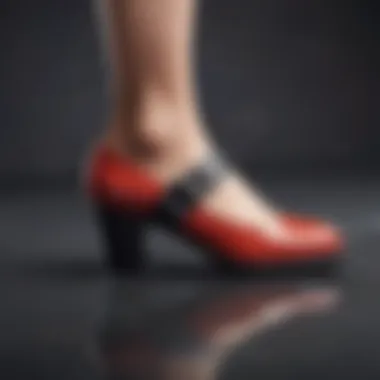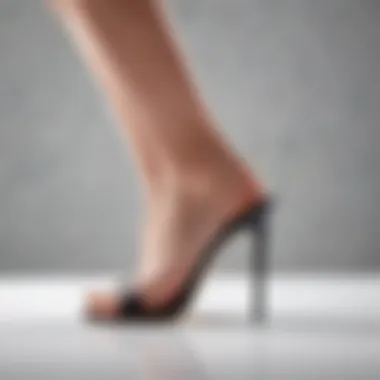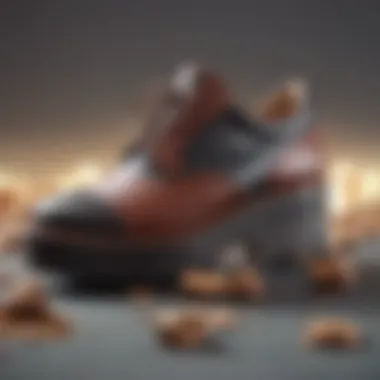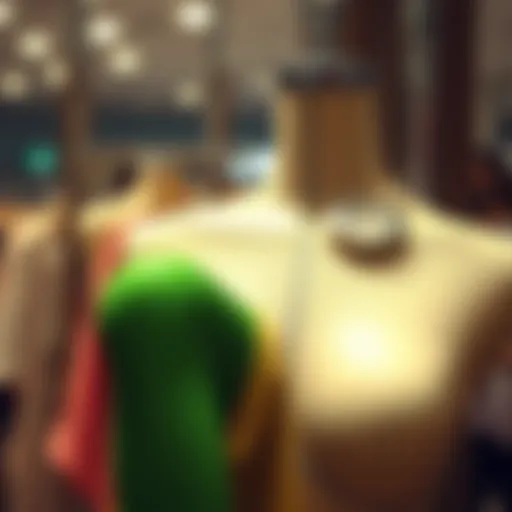Understanding Heel Slip: Causes and Solutions


Intro
Heel slip is a common battle that many encounter when it comes to footwear. It's that nagging sensation that occurs when the back of your foot lifts off the shoe's heel. Not only can this be uncomfortable, but it also affects the overall fit and feel of the shoes we wear daily. Many factors play a hand in this unfortunate event—from the shoe design to the material and how they cozy up with our feet.
Understanding heel slip goes beyond just figuring out the root problem. It involves digging deep into the elements that contribute to this phenomenon, the innovative solutions available, and the preventive measures we can take to avoid it altogether. This article aims to provide a thorough exploration of heel slip, offering insights valuable to designers, retailers, and even the everyday fashionista.
The relevance of tackling heel slip cannot be overstated. Proper fit in footwear enhances not just comfort, but also overall style. With heels slipping out, individuals might feel self-conscious or distracted from enjoying their day—whether at work, running errands, or enjoying a night out. Therefore, considering the implications of this issue is crucial for anyone interested in fashion, comfort, and practicality.
Equipped with knowledge about heel slip, you can make informed choices when selecting shoes or advising clients. In the following sections, we’ll break down the causes, identify effective solutions, and share insights on preventive measures that can be implemented for a more enjoyable and stylish experience.
Let's dive into the first section, which explores the current trends in footwear and insights that can help navigate the complexities of heel slip.
Preface to Heel Slip
The phenomenon of heel slip is a topic that affects a wide range of individuals from fashion enthusiasts to everyday sneaker wearers. It’s that annoying feeling when your foot simply won’t stay put in your shoe, leading to discomfort and sometimes, even injury. Understanding heel slip is crucial not only for personal comfort but for professionals involved in footwear design and retail.
When we talk about heel slip, it’s essential to recognize how a well-fitted shoe can elevate one’s ease of movement and style. Poor fit can turn the simplest stroll into a hassle, causing blisters and necessitating constant readjustment of footwear. For many, this is a daily struggle, casting a shadow on their choice of shoes, which ideally should be a source of pride rather than pain.
From a designer’s perspective, the implications of heel slip are profound. The fit and design of shoes directly govern customer satisfaction and loyalty. Addressing heel slip concerns can set a brand apart from competitors. Retailers benefit too; when they understand this issue, they can offer better service by recommending appropriate footwear solutions, ensuring that their clientele walks out happy.
Here are a few key points underscoring the importance of heel slip awareness:
- Comfort: A well-fitted shoe helps in achieving a pleasant wearing experience.
- Fashion Impact: Shoes that slip can detract from one’s overall aesthetic, turning heads for the wrong reasons.
- Health Considerations: Prolonged heel slip can lead to foot problems and injury, hindering one's lifestyle.
"A good pair of shoes should feel like a second skin, not a constant reminder of discomfort."
As we delve into the intricacies of heel slip, this article will offer insights into its causes, solutions, and preventive measures, positioning both designers and retailers to navigate the complex world of footwear with greater proficiency and understanding. The journey through these layers will be enlightening, ensuring that the discomfort of heel slip is addressed comprehensively and satisfactorily.
Defining Heel Slip
Understanding heel slip is vital for anyone involved in footwear design, retail, or even just an individual who cares about comfort while walking. This phenomenon is not merely an annoyance; it can significantly impact one’s experience with shoes, affecting everything from the wearer’s stability to their confidence. Many people don’t realize that heel slip can be a sign of deeper fitting issues or design flaws. By grasping what heel slip truly means and how it manifests in different types of footwear, stakeholders can take better steps towards ensuring a comfortable and stylish fit.
What is Heel Slip?
So, what exactly is heel slip? In simple terms, heel slip occurs when the heel of the foot moves up and down within the shoe while walking or running. It often presents itself as a noticeable gap between the heel and the shoe's counter – the part that wraps around the back of the ankle. A little bit of slip can feel normal but too much can lead to discomfort and instability.
Heel slip often varies depending on the shoe design, fit, and the dynamics of the wearer’s walking style. Think of it as a dance where the heel doesn’t stay in tune with the rhythm of the shoe’s movement. It can be influenced by several factors, such as the shape of the shoe last or the width of the heel area. Most importantly, understanding this concept aids in making informed decisions about footwear choice.
The Mechanics Behind Heel Slip
Diving deeper, the mechanics of heel slip involve the physical properties of the shoe and how they interact with the foot. When a person walks, the foot undergoes various forces: pressure, weight, and friction. Ideally, a well-fitted shoe allows the heel to remain snugly in place as the foot moves. However, if the shoe is too large or poorly designed, this balance can shift.
Several elements come into play:
- Foot Shape and Anatomy: Each person has a unique foot shape. A narrow heel may cause slipping in a wider shoe.
- Shoe Construction: A flimsily constructed heel counter may bend under pressure, leading to slip.
- Material and Flexibility: Materials that stretch too much can exacerbate heel slip.
To illustrate this, consider the analogy of trying to fit a square peg in a round hole. The mismatch not only creates frustration but also risks damage. Understanding these mechanics is key to grasping the broader impact of heel slip on footwear performance.
"When it comes to footwear, the perfect fit is not just about style; it’s about the very functionality of movement."
By appreciating these elements, designers and retailers can innovate and create footwear that minimizes heel slip issues, enhancing both comfort and aesthetic appeal.
Common Causes of Heel Slip
Understanding the common causes of heel slip is vital for preventing this discomfort in footwear. Recognizing these causal factors helps manufacturers and consumers alike to make informed choices about shoe selection and maintenance. When the underlying issues are addressed, it can lead to improved comfort, reduced physical stress on the feet, and enhanced overall satisfaction with footwear.


Improper Shoe Fit
Heel slip often starts with improper shoe fit. Shoes that are too large or wide leave too much space at the heel, causing the foot to move up and down with each step. For instance, someone might find that their favorite pair of boots, while stylish, are slightly loose because of their design. This leads to a frustrating experience, as every step feels unstable. Conversely, if shoes are too tight, they can create excessive friction, leading to blisters. It’s essential to properly measure your foot size and width, considering factors such as seasonal changes (feet can swell in the heat) and foot shape variations.
Material Imbalance
Another significant contributor is material imbalance. Shoes are often crafted from various materials, some of which don’t adhere well to the foot’s natural shape. A classic example is those trendy sneakers made of synthetic materials that lack the flexibility or cushioning that real leather might provide. When the materials don’t work together harmoniously, it may result in heel slip. Not only does this disrupt the wearer’s gait, but it may also cause undue strain on muscles and joints over time. Choose shoes thoughtfully, focusing on materials that fit your lifestyle and intended use.
Design Flaws
Design flaws are yet another aspect behind heel slip, often overlooked by consumers. Even the most exquisite designs may fall short functionally. For example, a pair of high-fashion heels may look stunning but might lack proper ankle support or heel caps designed to grip. Poorly thought-out ergonomics can turn what should be a delightful fashion statement into a source of frustration. When selecting shoes, examine their construction meticulously. Look for features like arch support, heel counters, and overall fit that truly marry style with comfort.
"To understand your feet is to grasp the essence of footwear design; a connection unseen but profoundly felt."
By addressing these common causes of heel slip—improper fit, material imbalance, and design flaws—consumers can significantly enhance their overall footwear experience. Designers and retailers can take this knowledge to heart, ensuring that comfort and style don’t exist in isolation but rather coexist to deliver a superior product.
Types of Footwear Prone to Heel Slip
Heel slip is an issue that can plague many footwear types, often leading to discomfort and diminished confidence while walking. Recognizing the types of shoes most susceptible to this problem can provide insights into preventive strategies and design improvements.
Footwear design plays a pivotal role in fit and comfort, which consequently affects the occurrence of heel slip. High heels, loafers, and sneakers may appear worlds apart, but they share the commonality of potentially leading their wearers into an uncomfortable experience if not designed with appropriate measures. Each type can demand unique attention regarding materials, fit, and overall structure to minimize the likelihood of heel slip.
High Heels
High heels are perhaps the most notorious for causing heel slip. While they can elevate a person's stature, they often compromise stability. The angle of inclination, combined with a narrow heel base, can create a precarious situation for the foot.
- Fit is Key: Shoes that are too loose can exacerbate heel slip, causing the foot to slide out with every step.
- Material Matters: Many high heels use smooth materials that lack grip, leading to further slipping. Opting for a textured interior can help.
- Consideration of Design: Some designs simply don't offer enough support around the ankle, leaving the heel exposed to movement. A closed back or a better contour can be a game changer.
Loafers and Slip-Ons
Loafers and slip-ons offer tremendous ease when it comes to wearing shoes but often overlook critical design elements that affect fit. The lack of laces or fasteners can lead to reduced grip on the heel.
- Sizing and Comfort: It's essential to select the correct size; a snug, yet comfortable fit helps keep the heel securely in place.
- Inner Support: Look for shoes with additional padding or support around the heel area. This can reduce slipping significantly.
- Material Composition: Soft, pliable materials can be great for comfort but might not hold your heel as effectively as a firmer material would.
Sneakers and Athletic Shoes
Contrary to what some may think, sneakers and athletic shoes are also not exempt from heel slip. While they tend to have more functional designs, the variance in fit and material can lead to unwanted movement during activities.
- Type of Exercise: Some sneakers are designed for specific sports, and wearing the wrong type can compromise fit. Ensure the shoe aligns with the intended activity.
- Insole Variation: Consider forefoot and heel cushioning that better holds the foot in place, which can prevent slip during movement.
- Lacing Techniques: Proper lacing can make a noticeable difference in how secure the heel feels. Experimenting with diverse lacing configurations might be essential for best fit.
Ensuring proper fit and design features can drastically reduce heel slip, enhancing both comfort and confidence in various footwear types.
Understanding these considerations guides not just consumers but designers and retailers towards making informed choices. The nuances of heel slip can be mitigated by thoughtful selection of materials and an emphasis on fit, making all the difference in overall comfort and satisfaction.
Impact of Heel Slip on Comfort and Style
Heel slip can dramatically affect both comfort and style, influencing how a person feels and presents themselves. If you’re constantly adjusting your shoes, unable to focus on your day-to-day tasks or feel self-conscious about your appearance, it’s clear that heel slip is not just a trivial issue. Understanding its impact can lead to better choices in footwear and enhanced personal comfort.
Physical Discomfort
Wearing shoes that slip at the heel can lead to a range of physical discomforts. First and foremost, the lack of stability can cause friction. Often, this constant movement creates irritation, leading to blisters or calluses. It also strains the foot's musculature, which can result in pain in other areas like the knees, hips, or even the lower back over time. For example, someone wearing high heels with heel slip may find themselves favoring one leg over the other, which can create lasting imbalances. Not to mention, the mental toll of discomfort can be quite significant, distracting from one’s daily activities.
In more practical terms:
- Blisters form as the foot moves excessively within the shoe.
- Arch pain and plantar fasciitis can develop if the foot is not properly secured.
- Slipping can inhibit normal gait patterns, leading to awkward walking and additional joint stress.
Aesthetic Considerations


When it comes to style, heel slip can disrupt the sleek silhouette many strive for in high-fashion footwear. A shoe’s appearance is often marred by the visible gaps that occur when the heel does not sit snugly. Imagine a polished outfit accessorized with a pair of heels that seem oversized or misfitting—that’s immediately noticeable and can detract from an otherwise well-put-together look.
Moreover, the aesthetic impact goes beyond mere appearance. Shoes that slip tend to compromise the wearer’s poise. Confidence plays a key role in style presentation, and when footwear lacks comfort and fit, the overall impression might become less favorable.
Some points of consideration include:
- Visibility of Gaps: The space between the shoe and heel can draw unwanted attention.
- Misalignment with Fashion Trends: Many trends prioritize clean lines, and poorly fitting shoes could miss the mark.
- Personal Brand Reflection: For influencers and professionals, footwear choices communicate a message about personal style and attention to detail.
"A well-fitted shoe is often a silent supporter of one's style and comfort; heel slip, however, can be its loudest detractor."
Through a mistaken purchase, one can easily find themselves wrestling with both discomfort and diminished style. Addressing heel slip not only uplifts comfort levels but can also reinstate confidence in how one feels and looks. The interplay between foot health and overall style can't be underestimated in the pursuit of a complete fashion experience.
Solutions to Mitigate Heel Slip
Addressing heel slip is essential, not just for comfort but for overall foot health. Getting rid of this issue can enhance one’s confidence, making every step feel secure. In this section, we will explore specific strategies aimed at minimizing heel slip, ensuring that individuals can enjoy their footwear without the nagging annoyance that often accompanies movement.
Choosing the Right Fit
Finding the right size is foundational to preventing heel slip. A shoe too big will naturally lead to slippage. When trying on shoes, checking for a snug fit at the heel is crucial. Walk around the store to test how the shoes feel. If the heel moves excessively, it’s a sign to reconsider the size or style. Remember: your foot measures may change over time due to various factors like age and activity levels, so reassessing fit regularly is wise.
Material Selection
Different materials offer varying levels of breathability and comfort. Leather, for example, may compress over time, leading to heel slippage. Alternately, materials like suede can grip the foot better and reduce slipping. Manufacturers are also starting to experiment with newer synthetic options that are designed to minimize slippage while providing adequate support. When selecting shoes, consider the material and how it molds to your foot’s shape. Check if the interior is sufficiently padded to hold your heel in place securely.
Using Insoles and Cushions
Insoles can be a game changer when it comes to heel slip. They fill extra space and create a customized fit for the wearer. Gel insoles can distribute pressure evenly and prevent sliding. When choosing insoles, opt for those that offer both comfort and grip. Look for designs specifically targeting heel stability. Additionally, cushions around the ankle can create a better fit and enhance security, making the shoes feel like a second skin. Always remember to measure how your foot aligns with the insole – it should not feel cramped but snug.
Footwear Maintenance
Regular maintenance of footwear can greatly impact its effectiveness in preventing heel slip. Keep shoes clean and stored properly to maintain their shape. For instance, over time let’s say, a shoe’s structure can be compromised if not positioned correctly. Regularly checking for wear and tear, especially in the gripping areas, is essential. If you observe the breakdown of rubber soles or padding, it’s time to give them a good clean or even replace them.
"A well-maintained shoe tells a story of care, comfort and confidence."
Finale
In summary, tackling heel slip involves understanding the components of shoe fit, material, and proper upkeep. Making informed choices in these areas not only heighten comfort but can ultimately shape the quality of each step taken. When designers, retailers, and consumers prioritize these measures, the shoe experience transforms from one of frustration to fluidity.
Preventive Measures for Heel Slip
Preventing heel slip is a significant factor in ensuring both comfort and style when selecting and using footwear. The right preventive measures can help individuals avoid common issues associated with improper fit and inadequate support. Proper management of heel slip can enhance the overall wearing experience, allowing for longer periods of use without discomfort. Understanding these measures is vital for designers, retailers, and fashion enthusiasts alike, as it contributes not only to customer satisfaction but also to brand reputation.
Proper Sizing Techniques
When it comes to fitting shoes, many folks underestimate the importance of sizing techniques. A correct shoe size may seem straightforward, but it's an art that often requires a keen eye. First off, measuring one’s foot is essential. Many people have one foot larger than the other; thus, it's prudent to size based on the larger foot.
- Try shoes on in the afternoon: Our feet tend to swell throughout the day, so fitting them at this time can yield a more accurate size.
- Check the toe box: Ensure there is about a thumb's width of space between the toe and the front of the shoe. This helps to prevent the foot from sliding forward, which can exacerbate heel slip.
- Use a Brannock device: This tool provides accurate measurements of both width and length, offering a better idea of what size would actually fit.
These steps can help in preventing heel slip substantially, as a well-fitted shoe can significantly reduce movement at the heel.
Regular Footwear Assessments
Regular assessments of footwear are also essential in the fight against heel slip. Shoes wear down at different rates depending on the materials used and the activities for which they were intended. Periodic checks can help gauge the condition of the shoes and their ability to provide necessary support and comfort.
- Inspect the heel: Look for wear patterns on the heel area, which can signal that shoes are no longer performing as intended.
- Examine the insole: A flattened insole may not provide adequate cushioning, leading to inadequate support and potential heel slip.
- Check the overall construction: Over time, seams and bindings may weaken, and materials might stretch, offering less control over foot movement.


By routinely inspecting footwear for signs of wear and ensuring proper fit, individuals can enjoy a more stable and comfortable fit, significantly decreasing the likelihood of heel slip.
"Preventive measures not only enhance comfort but can extend the life of your shoes, offering better value for your investment."
Design Innovations Addressing Heel Slip
The evolution of footwear design plays a significant role in tackling the issue of heel slip. Innovative approaches not only enhance comfort but also improve the overall performance and aesthetic appeal of shoes. As the market adapts to consumer needs, understanding these innovative design choices becomes key for designers, retailers, and fashion-conscious individuals.
Technological Advancements
Recent years have witnessed a surge in technology-based solutions to address heel slip. Fabrics that enhance grip and structural integrity are at the forefront of these solutions. For instance, some brands have begun to use specially designed outsoles that incorporate rubberized materials for superior traction against the heel. This prevents excessive movement within the shoe, thereby reducing heel slip remarkably.
Moreover, advancements in 3D printing technology allow for the development of customized shoes tailored to individual foot shapes. This means better fitting shoes that can conform precisely to the contours of a person’s foot. The use of data-driven design tools has also enabled brands to analyze foot dynamics extensively. This kind of information drives innovation in footwear, ensuring that heel slip becomes a concern of the past rather than a common nuisance.
Brands Leading the Way
Several brands have made notable strides in engineering designs that effectively address heel slip. For one, Nike has incorporated innovative flyknit materials that ensure a snug fit without compromising breathability. The innovation allows for expansion and contraction, adapting to your foot as it moves.
Another brand, Clarks, has focused on developing heel grips in its footwear range. Their approach includes using silicone lining around the heel area, creating friction that prevents the foot from slipping out.
Adidas has not been left behind either. Their Boost technology provides cushioning that adapts underfoot pressure, which enhances stability and minimizes slip. With brands like these leading the charge, there's an optimistic path ahead for anyone looking to say goodbye to heel slip.
"With continuous advancements, the gap between comfort and style in footwear is closing. Brands are innovating solutions quickly, addressing heel slip issues before they escalate into major concerns."
By exploring these innovations, both designers and consumers can make informed decisions that significantly enhance comfort and style in footwear. It's clear that smart design decisions, backed by cutting-edge technology, offer a promising outlook for those plagued by heel slip.
Expert Opinions on Heel Slip
The discussion around heel slip is complex and multifaceted. It's not just about discomfort; it reflects on the craftsmanship of footwear, the science of fit, and the subjective experiences of users. Gaining insight from industry experts—designers and retailers—adds layers of understanding that enhance our knowledge. Such expertise can guide individuals in selecting the right footwear, making informed decisions based on professional recommendations and trends in shoe designs. With varying perspectives focused on practical experiences, these insights play an essential role in navigating the intricacies of heel slip.
Insights from Designers
Designers are the architects of footwear. They blend function with fashion, creating shoes that need not only to look good but also provide comfort. Designers emphasize the intricacies involved in producing footwear that prevents heel slip.
- Unique Design Features: Designers often mention structural enhancements such as heel counters, which are stiff areas that cradle the heel, providing added support. This is critical in shoes that face higher heel slip risk.
- Material Choices: The choice of material has significant implications. Soft leathers offer comfort while more rigid options can provide stability. Designers frequently highlight how combining different materials can lead to a better fit, ensuring that the shoe conforms well to the foot shape and minimizes movement.
- Foot Shape Consideration: Each foot is unique. Designers advocate for considering different foot shapes when creating footwear. Understanding that not every shoe model will suit every foot is part of the process. They recommend custom fittings when possible, allowing for tailored adjustments that can alleviate heel slip issues.
Here's a pertinent insight from a prominent designer:
"The interaction between the foot and the shoe must be seamless. If the shoe isn't working with the foot, heel slip becomes inevitable."
Comments from Footwear Retailers
Retailers are often the frontline in observing customer experiences with heel slip. Their insights can be particularly enlightening as they interact with a wide variety of consumers and shoes.
- Customer Feedback: Retailers highlight the importance of listening to customer feedback. Many customers express frustration about heel slip, and addressing this can boost sales and satisfaction. Retail staff with training on fit and comfort directly contribute to positive shopping experiences.
- Best-Selling Styles: Retailers often track which shoe styles tend to have higher return rates due to heel slip complaints. They report that certain designs, especially those with narrow fits or lack of adjustability, see more returns, prompting brands to reconsider their approaches.
- Practical Solutions: Retailers recommend practical solutions like using heel grips or purchasing shoes with adjustable features, such as straps or laces, to optimize fit. They often state that simply understanding how a shoe should fit can drastically decrease the likelihood of heel slip.
Footwear retailers often say:
"A perfect fit isn't just about size; it's about how the shoe adapts to the foot's shape and movement."
The End
In wrapping up the discussion on heel slip, it becomes clear that understanding its intricacies is crucial not just for individual comfort but also for the overall integrity of footwear design. Assessing heel slip involves delving into various elements—shoe fit, material choices, and innovative design methods that can collectively mitigate this pervasive issue.
The benefits of addressing heel slip extend beyond personal comfort into the realm of fashion and professionalism. For designers and retailers, recognizing the nuances of heel slip allows for the creation of products that not only function well but also enhance customer satisfaction. Potential buyers are likely to gravitate toward brands that prioritize comfort without sacrificing style. The aesthetic considerations associated with heel slip can't be understated; a well-fitted shoe contributes to a confident stride, which enhances both personal image and brand reliability.
Moreover, the article explores preventive measures that can be woven into the fabric of footwear selection. Regular assessments of fit, design innovations, and the integration of feedback from users can create a more harmonious relationship between the wearer and their shoes. By keeping a finger on the pulse of consumer needs, brands can proactively develop solutions tailored to minimize heel slip.
Such strategic approaches not only improve current offerings but also pave the way for future innovations in the footwear industry. In a landscape where comfort is as critical as style, those engaged in shoe design and retail must prioritize strategies that address heel slip effectively.
"Addressing heel slip is more than a technical challenge; it's an opportunity to redefine comfort in fashion."
Ultimately, the insights shared throughout this article serve to equip stakeholders—from designers to end-users—with the knowledge needed to make informed decisions. The discussion around heel slip is not merely academic; it's a practical guide that emphasizes the importance of thoughtful footwear choices.



